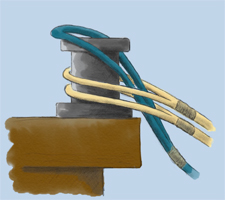Dinghy Dock Etiquette
By Tom Hale
In most coastal towns shore access for cruisers is limited. There are some dinghy docks and public landings, but often dinghy docks are crowded. In season these landings can be very crowded. Over time, a simple set of dinghy dock guidelines has evolved amongst cruisers. They make it much easier for you and everyone at else at the dinghy landing:
- Always leave your outboard down. Raised outboards can damage other boats. Even in salt water, leaving your lower unit in the water for a few hours is not going to damage it. It is designed and engineered for this.
- Have a long painter, about twice as long as your dinghy. Tie to the dinghy dock with a long painter. This allows others to push aside the dinghies and nose up to the dock and unload.
- If you use a short painter everyone coming in after you will have to climb through your dinghy both coming and going.
- If shore access is via a ladder, once you are ashore, move your dinghy away from the ladder, leaving room for others to land and unload.
- Use only one dock line. If you tie alongside, it leaves less room for others, and requires others to clamber through your boat to get ashore.
- Usually at the dinghy dock, there are only a few dock cleats. If you cleat your painter, and then the next arrival cleats on top of you and then the next, it soon becomes a rat’s nest. The person with the painter on the bottom is going to have to untie all the painters on top and retie them, securely you hope. So, it is best not to cleat the painter.
- Pass you painter through the center of the cleat and tie your painter back to itself with a bowline. There is always more room for a lot of looped painters if no one has cleated their painter.
- If other dinghies are at the dock, try to tie your dinghy painter below the earlier arrivals.They will most likely be leaving before you. You might not want them to have to untie your dinghy and retie it. Passing your painter up through the loops of other painters is sometimes known as “dipping the eye.”
- If you lock your dinghy be sure the cable is long, preferably longer than your boat to allow others to nose into the dock to unload.

